This post examines the recent reassessment of Saudi Arabia’s bold megacity, THE LINE. It explores what its scaled‑back trajectory means for architects, engineers, planners, and investors.
I break down the practical changes being reported. The post also explains why the project is being reined in and how the initiative is being reframed as a long‑term laboratory for future urban systems.
Why THE LINE is changing course
THE LINE was once pitched as a 170‑kilometer, car‑free, carbon‑neutral city through the desert. Two 500‑meter‑high mirrored walls would conceal an ultra‑compact city, making it the most visible symbol of Saudi Arabia’s Vision 2030.
It was central to the $500‑billion NEOM development and the kingdom’s ambition to diversify beyond oil. The project aimed to position Saudi Arabia as a global innovation and tourism hub.
Recent reports and official statements show the project is being scaled back. Construction has slowed, and only a few miles of the original corridor are now under development.
Book Your Dream Vacation Today
Flights | Hotels | Vacation Rentals | Rental Cars | Experiences
What has been scaled back
The retrenchment is part of a broader fiscal “course correction” across Saudi megaprojects. Several related developments have seen delays or reduced scopes, including:
Project leaders say THE LINE is not canceled. NEOM now presents it as a long‑term experiment, with future investments in AI, gaming, and data infrastructure as part of a phased, technology‑driven build‑out.
What this means for design and engineering practice
As an architect and engineer with three decades of international experience, I see both pragmatic necessity and opportunity in this pivot. Large visionary projects often need iterative delivery models.
A phased, performance‑driven approach is more realistic than a single all‑or‑nothing construction surge.
Practical implications and lessons
Key takeaways for professionals and stakeholders include:
Opportunities in the “laboratory” framing
Reframing THE LINE as a long‑term laboratory is an invitation to experiment with urban technologies that can be validated and scaled. For engineers and urbanists, this opens opportunities to deploy digital twins, AI‑driven building management, microgrid experiments, and advanced water‑recycling systems in contained pilots.
How to make pilots meaningful
Pilots must be designed to generate transferable knowledge. This requires clear metrics for carbon performance, mobility efficiency, liveability, and cost per unit of infrastructure.
Transparency in results will attract private investment. It will also help accelerate maturity for domestic and exportable solutions.
Here is the source article for this story: is THE LINE still becoming reality as saudi arabia reimagines its architectural future?
Book Your Dream Vacation Today
Flights | Hotels | Vacation Rentals | Rental Cars | Experiences

